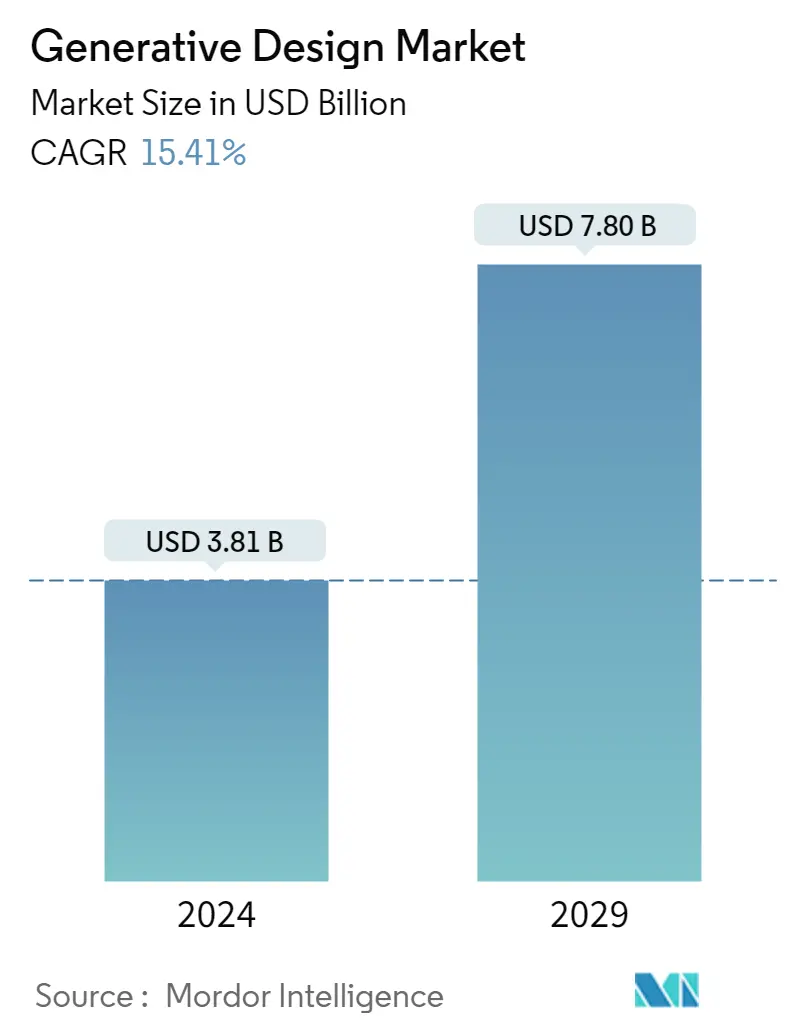Market Size of Generative Design Industry

| Study Period | 2021 - 2029 |
| Market Size (2024) | USD 3.81 Billion |
| Market Size (2029) | USD 7.80 Billion |
| CAGR (2024 - 2029) | 15.41 % |
| Fastest Growing Market | Asia Pacific |
| Largest Market | North America |
Major Players
*Disclaimer: Major Players sorted in no particular order |
Generative Design Market Analysis
The Generative Design Market size is estimated at USD 3.81 billion in 2024, and is expected to reach USD 7.80 billion by 2029, growing at a CAGR of 15.41% during the forecast period (2024-2029).
The upcoming trend of designing toolsets with machine learning capabilities contributes to the growth of the market studied. Significant investments made during last year aimed at empowering designers to reduce the number of errors, thereby saving considerable time, are expected to produce results in the future.
- The growing demand for advanced manufacturing with complex designs and the need to reduce the size while improving the performance of automotive compels automotive manufacturers to increase their R&D investments and adopt generative designing.
- Companies such as Airbus, Black & Decker, Under Armour, and other massive corporations embrace generative design as a trend molding the future of the engineering industry. It enables engineers to hand the reins off to their CAD software to naturally find the best solutions to a given set of constraints. It augments the engineer's imagination.
- Generative design is in the initial development stage, meaning that early users may come across specific challenges. For instance, defining a design problem in computable terms, which generative design software has to solve, will include a steep learning curve. Engineers need to be more experienced with revealing the design problem as a set of parameters may end up with loosely defined structural restraints or loads, ultimately resulting in a failed design.
- There are over 30,000 parts in an average car, and creating all these pieces and then putting them together requires an incredibly complex supply chain and manufacturing capabilities. However, General Motors and the San Francisco-based software company Autodesk plan to upend how cars are designed, reducing the number of car parts that go into each vehicle while making cars both lighter and more robust.
- Another point to consider with the generative design is that efficient methods can only sometimes be manufactured. For instance, in a Renishaw case study, engineers topologically optimized a suspension bell crank. They should have considered the optimized part's manufacturability. It resulted in a design that demanded a lot of supports to be printed, whereas a good practice is to design pieces with fewer supports as needed as possible. Such instances are anticipated to lay a negative impact on the market.
- However, generative design is used to help address the risks related to COVID-19. For instance, Digital Blue Foam is developing a tool to help address the risks associated with the use and occupancy of interior spaces due to COVID-19. Covid Space Planner analyses factors such as total occupancy and proximity, airflow and ventilation, and the duration of activity in the space. Based on these factors, the tool applies Digital Blue Foam's generative design capabilities to recommend spatial planning strategies, such as the location of entry points, work areas, furniture placement, and retrofits, to mitigate the risk.
Generative Design Industry Segmentation
Engineering software known as generative design automatically develops high-performance design iterations based on performance or space requirements, manufacturing processes, materials, and costs. It uses artificial intelligence (AI) algorithms to create highly customized complicated structures and internal lattices that are impossible to construct using traditional manufacturing techniques.
The Generative Design Market is segmented by Deployment (On-premise, Cloud), End User Vertical (Automotive, Aerospace and Defense, Architecture and Construction, Manufacturing Machinery), and Geography.
The market sizes and forecasts are provided in terms of value (USD million) for all the above segments.
| Deployment | |
| On-premise | |
| Cloud |
| End User Vertical | |
| Automotive | |
| Aerospace and Defense | |
| Architecture and Construction | |
| Industrial Manufacturing | |
| Other End User Verticals |
| Geography | |||||||
| |||||||
| |||||||
| |||||||
| |||||||
|
Generative Design Market Size Summary
The generative design market is poised for significant growth, driven by advancements in machine learning and the increasing demand for complex, efficient manufacturing solutions. This technology is gaining traction across various industries, particularly in automotive and aerospace, where companies like Airbus and General Motors are leveraging it to enhance design efficiency and reduce material usage. Generative design allows engineers to explore a broader range of design possibilities by setting specific parameters, thereby optimizing performance and reducing weight. This is especially crucial in the automotive sector, where reducing vehicle weight can lead to improved energy efficiency, a key consideration for electric vehicles. Despite its potential, the technology is still in its early stages, presenting challenges such as the need for experienced engineers to define design problems accurately.
In Europe, the generative design market is experiencing robust growth, fueled by the region's strong automotive sector and the increasing adoption of 3D printing technologies. Major automotive players like Audi and Volkswagen are integrating generative design into their production processes to enhance vehicle performance and reduce dependency on complex supply chains. The rise in electric vehicle sales further propels the demand for lightweight components, making generative design an attractive solution. Additionally, the manufacturing industry in Europe is embracing additive manufacturing, supported by government initiatives to upskill the workforce. The COVID-19 pandemic has also accelerated the adoption of generative design, particularly in healthcare, where 3D printing has been crucial in producing medical equipment. The market remains moderately fragmented, with key players like Autodesk, Dassault Systèmes, and Altair Engineering driving innovation and competition.
Generative Design Market Size - Table of Contents
-
1. MARKET INSIGHTS
-
1.1 Market Overview
-
1.2 Industry Attractiveness - Porter Five Forces
-
1.2.1 Bargaining Power of Suppliers
-
1.2.2 Bargaining Power of Consumers
-
1.2.3 Threat of New Entrants
-
1.2.4 Intensity of Competitive Rivalry
-
1.2.5 Threat of Substitute Products
-
-
1.3 Industry Stakeholder Analysis
-
1.4 Impact of COVID-19 on the Industry Ecosystem
-
-
2. MARKET SEGMENTATION
-
2.1 Deployment
-
2.1.1 On-premise
-
2.1.2 Cloud
-
-
2.2 End User Vertical
-
2.2.1 Automotive
-
2.2.2 Aerospace and Defense
-
2.2.3 Architecture and Construction
-
2.2.4 Industrial Manufacturing
-
2.2.5 Other End User Verticals
-
-
2.3 Geography
-
2.3.1 North America
-
2.3.1.1 United States
-
2.3.1.2 Canada
-
2.3.1.3 Rest of North America
-
-
2.3.2 Europe
-
2.3.2.1 Germany
-
2.3.2.2 United Kingdom
-
2.3.2.3 France
-
2.3.2.4 Spain
-
2.3.2.5 Rest of Europe
-
-
2.3.3 Asia-Pacific
-
2.3.3.1 China
-
2.3.3.2 Japan
-
2.3.3.3 India
-
2.3.3.4 Rest of Asia-Pacific
-
-
2.3.4 Latin America
-
2.3.4.1 Brazil
-
2.3.4.2 Argentina
-
2.3.4.3 Rest of Latin America
-
-
2.3.5 Middle East and Africa
-
2.3.5.1 UAE
-
2.3.5.2 Saudi Arabia
-
2.3.5.3 South Africa
-
2.3.5.4 Rest of Middle East and Africa
-
-
-
Generative Design Market Size FAQs
How big is the Generative Design Market?
The Generative Design Market size is expected to reach USD 3.81 billion in 2024 and grow at a CAGR of 15.41% to reach USD 7.80 billion by 2029.
What is the current Generative Design Market size?
In 2024, the Generative Design Market size is expected to reach USD 3.81 billion.

